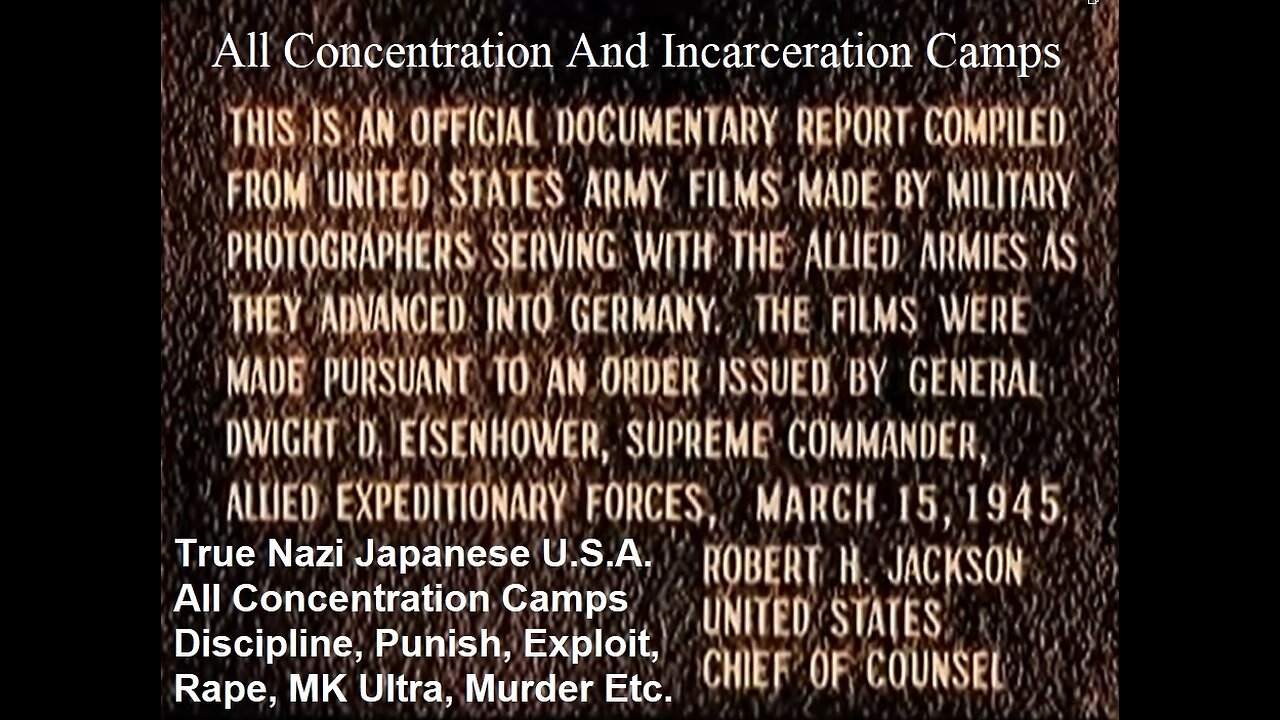Premium Only Content

Nazi-Japanese-U.S.A. Concentration Camps Discipline, Punish, Exploit And Murder
Nazi Germany was a land of camps. The Nazis set up many different types of camps: camps to discipline, punish, exploit and murder. Concentration camps stood at the center. They helped to establish Nazi rule, led the brutal assault on outsiders and opponents, and engaged in the murderous war against Jews. More than 6 to 7 million men, women and children died in concentration camps between 1933 and 1945. This page lists the main camp complexes under the SS Inspectorate of Concentration Camps and the WVHA-D (with the exception of the special camp Hinzert and the training camp Debica). Other Nazi camps, including death camps like Treblinka, Sobibor, Belzec and Chelmno, are not included. Please note that prisoner and mortality figures are often rough estimates. Also, as many prisoners went through several camps, they were often counted more than once.
In 1945, the Nazis created six extermination camps, including Chemno, Belzec, Sobibor, Treblinka, Majdanek, and Auschwitz-Birkenau. Auschwitz and Majdanek were also used for labor-based extermination. Bergen-Belsen was liberated by the British on 15 April 1945, but unsanitary conditions did not improve immediately. Between 1936 and 1945, more than 200,000 people were interned in Sachsenhausen concentration camp, including political opponents of the Nazi regime, members of groups declared by the Nazis to be racially or biologically inferior, and people persecuted as homosexuals. Initially, the internees were predominantly German citizens, but after the outbreak of the Second World War, tens of thousands of people were deported from the occupied territories to Sachsenhausen concentration camp, including political opponents of National Socialism or of the collaborating governments, foreign forced laborers, and Allied prisoners of war. At the beginning of 1945, some 80,000 people were incarcerated in Sachsenhausen concentration camp and its satellites, of whom 58,000 were in the Sachsenhausen main camp. On April 29, 1945, units of the U.S. Army liberated.
World War Two was a global war that lasted from Sept. 18-1931 to Aug. 14-1945 Explore the true timeline of key events before and during World War 2. The mass murder of Europe’s Jews took place in the context of World War Two. As German troops invaded and occupied more and more territory in Europe, the Soviet Union, and North Africa, the regime’s racial and anti-Semitic policies became more radical, moving from persecution to genocide. America's isolation from war ended on December 7, 1941, when Japan staged a surprise attack on American military installations in the Pacific.
The Second Sino-Japanese War was a full-scale war between China and the Empire of Japan that lasted from 1931 to 1945. China was aided by the Soviet Union, the United Kingdom, the United States, and Nazi Germany before its alliance with Japan. The war is often regarded as the beginning of World War II in Asia, although some scholars consider the European War and the Pacific War to be entirely separate, albeit concurrent. Around 20 million people, mostly civilians, were killed in the war. The United States advised and supported China's ground war, while basing only a few of its own units in China for operations against Japanese forces in the region and Japan itself. The war's end brought a devastating blow to American diplomacy as China ultimately fell to communism, forever changing the global balance of power in the emerging Cold War.
Rape of Nanking: 1937-1938 300,000 Deaths
In China. In December of 1937, the Japanese Imperial Army marched into China's capital city of Nanking... Sad !
file:///E:/Matrix%20Software%20Sinclair%20-%201420/Matrix%20-%20A-ASoft-00/The%20History%20Place%20-%20Genocide%20in%20the%2020th%20Century_%20Rape%20of%20Nanking%201937-38.html
Japanese-American Incarceration During World War II
In his speech to Congress, President Franklin Delano Roosevelt declared that the Japanese attack on Pearl Harbor on December 7, 1941, was "a date which will live in infamy." The attack launched the United States fully into the two theaters of World War II – Europe and the Pacific.
https://en.wikipedia.org/wiki/Internment_of_Japanese_Americans
Japanese internment camps were established during World War II by President Franklin D. Roosevelt through his Executive Order 9066. From 1942 to 1945, it was the policy of the U.S. government that people of Japanese descent, including U.S. citizens, be incarcerated.
In the 1930s, the Great Depression and the memory of tragic losses in World War I contributed to pushing American public opinion and policy towards isolationism. Isolationists advocated non-involvement in European and Asian conflicts and non-entanglement in international politics. Although the United States took measures to avoid political and military conflicts across the oceans, it continued to expand economically and protect its interests in Latin America. Isolationists believed that World War II was ultimately a dispute between foreign nations and that the United States had no good reason to get involved. The best policy, they claimed, was for the United States to build up its own defenses and avoid antagonizing either side. After the attack on Pearl Harbor, isolationists such as Charles Lindbergh's America First Committee and Herbert Hoover announced their support of the war effort.
World War II was a global conflict that lasted from 1939 to 1945. The main combatants were the Axis powers (Germany, Italy, and Japan) and the Allies (France, Great Britain, the United States, the Soviet Union, and China). The European theater of World War II saw heavy fighting across Europe for almost six years, starting with Germany's invasion of Poland on 1 September 1939 and ending with the Western Allies conquering most of Western Europe, the Soviet Union conquering most of Eastern Europe including the German capital Berlin and Germany's unconditional surrender on 8 May 1945. The war continued primarily between the European Axis powers and the British Empire, with war in the Balkans, the aerial Battle of Britain, the Blitz of the United Kingdom, and the Battle of the Atlantic. The SOE operated in every nation in Europe and southeast Asia that was under the rule of an Axis power. Adolf Hitler and his National Socialist (Nazi Party) rearmed the nation and signed treaties with Italy and Japan to further his ambitions of world domination.
The League of Nations was established in 1919 by the victorious Allied powers after World War I. The League began organizational work in the fall of 1919, spending its first 10 months with a headquarters in London before moving to Geneva. The Covenant of the League of Nations went into effect on January 10, 1920, formally instituting the League of Nations. The League was seen as the epitome of a new world order based on mutual cooperation and the peaceful resolution of international conflicts. The Covenant bound its Member States to try to settle their disputes peacefully. By joining the League, Member States also renounced secret diplomacy, committed to reduce their armaments, and agreed to comply with international law. Although the League was unable to fulfill the hopes of its founders, its creation was an event of decisive importance in the history of international relations.
"World War II in Colour" is a 13-episode British television docuseries that recounts the major events of World War II, covering the Western Front, Eastern Front, North African Campaign, and the Pacific War. The show is in full color, combining both original and colorized footage. New programme had got to the point of war in its timeline. "Greatest Events of WWII in Colour" is a docuseries that documents some of the events of World War II while showing colorized archive footage of such events.
World War II may have started more than 75 years ago, but people still think about it a lot. You cannot go online without seeing someone be compared to Hitler or the Nazis. Hollywood cannot churn out movies about it fast enough, and there are thousands of books to read on the subject. Even people who don't normally consider themselves history experts are pretty sure they know the basics when it comes to World War II.
https://www.historyplace.com/worldhistory/genocide/holocaust.htm
Except so much of what we think we know is wrong. Propaganda was flying around from all sides during the war, and even after all these years we still believe some of it. Hindsight has made some countries into cowards and some into heroes, while leaders from the time are either completely evil or pure perfection. Obviously, anything as messy as war is a lot more complicated than that. Here are some of the biggest myths you probably believe about World War Two.
https://en.wikipedia.org/wiki/Extermination_camp
The unit 731 is estimated to have killed between 200,000 and 300,000 people. It was based in the Pingfang district of Harbin, the largest city in the Japanese puppet state of Manchukuo (now Northeast China, formerly named Manchuria) and had active branch offices throughout China and Southeast Asia.
human experiments program mk ultra General Accounting Office issued ... of human subjects in tests and experiments involving hazardous substances. ... ... Working with the CIA, the Department of Defense gave hallucinogenic drugs to thousands of "volunteer" soldiers in the 1950's and 1960's. In addition to LSD, the Army also tested quinuclidinyl benzilate, a hallucinogen code-named BZ. (Note 37) Many of these tests were conducted under the so-called MKULTRA program.
https://www.history.com/mkultra-operation-midnight-climax-cia-lsd-experiments
MK-Ultra’s “mind control” experiments generally centered around behavior modification via electro-shock therapy, hypnosis, polygraphs, radiation, and a variety of drugs, toxins, and chemicals. These experiments relied on a range of test subjects: some who freely volunteered, some who volunteered under coercion, and some who had absolutely no idea they were involved in a sweeping defense research program...
https://en.wikipedia.org/wiki/MKUltra
SS physician Josef Mengele conducted inhumane, and often deadly, medical experiments on prisoners at Auschwitz. He became the most notorious of the Nazi doctors who conducted experiments at the camp. Mengele was nicknamed the "angel of death." He is often remembered for his presence on the selection ramp at Auschwitz.
Josef Mengele is one of the most infamous figures of the Holocaust. His service at Auschwitz and the medical experiments he conducted there have made him the most widely recognized perpetrator of the crimes committed at that camp. His postwar life in hiding has come to represent the international failure to bring the perpetrators of Nazi crimes to justice.
Because of his infamy, Mengele has been the subject of numerous popular books, films, and television shows. Many of these portrayals distort the real facts of Mengele’s crimes and take him out of his historical context. Some portray him as a mad scientist who conducted sadistic experiments with no scientific basis.
The truth about Mengele is even more disturbing. He was a highly trained doctor and medical researcher, as well as a decorated war veteran. He was respected in his field and worked for one of the leading research institutions in Germany. Much of his medical research at Auschwitz supported the work of other German scientists. He was one of dozens of biomedical researchers who conducted experiments on prisoners in Nazi concentration camps. And he was one of a number of medical professionals who selected victims to be murdered in the gas chambers at Auschwitz.
Mengele acted within the norms of German science under the Nazi regime. His crimes represent the extreme danger posed by science when it is conducted in the service of an ideology that denies the rights, dignity, and even humanity of certain groups of people.
https://en.wikipedia.org/wiki/Nazi_concentration_camps
Mengele before Auschwitz
Josef Mengele was born on March 16, 1911, in the Bavarian city of Günzburg, Germany. He was the eldest son of Karl Mengele, a prosperous manufacturer of farming equipment.
Mengele studied medicine and physical anthropology at several universities. In 1935, he earned a PhD in physical anthropology from the University of Munich.
In 1936, Mengele passed the state medical exams.
In 1937, Mengele began working at the Institute for Hereditary Biology and Racial Hygiene in Frankfurt, Germany. There, he was an assistant to the director, Dr. Otmar von Verschuer. Verschuer was a leading geneticist known for his research on twins. Under Verschuer’s direction, Mengele completed an additional doctorate in 1938.
Embracing Nazi Ideology
Mengele did not actively support the Nazi Party before it came to power. However, in 1931, he joined the Stahlhelm, the paramilitary of another right-wing party, the German National People’s Party. Mengele became a member of the Nazi SA when it absorbed the Stahlhelm in 1933, but he ceased actively participating in it in 1934.
During his university studies, however, Mengele embraced racial science, the false theory of biological racism. He believed that Germans were biologically different from and superior to members of all other races. Racial science was a fundamental tenet of Nazi ideology. Hitler used racial science to justify the forced sterilization of persons with certain physical or mental diseases or physical deformities. The Nuremberg Race Laws, which outlawed marriage between Germans and Jewish, Black, or Romani peoples, were also based upon racial science.
In 1938, Mengele joined the Nazi Party and the SS. In his work as a scientist, he sought to support the Nazi goal of maintaining and increasing the supposed superiority of the German “race.” Mengele’s employer and mentor, Verschuer, also embraced biological racism. In addition to conducting research, Verschuer and his staff—including Mengele—provided expert opinions to Nazi authorities who had to determine whether persons qualified as German under the Nuremberg Laws. Mengele and his colleagues also evaluated Germans whose physical or mental condition might qualify them to be forcibly sterilized or barred from marriage under German law.
Serving on the Eastern Front
In June 1940, Mengele was drafted into the German army (Wehrmacht). A month later, he volunteered for the medical service of the Waffen-SS (the military branch of the SS). At first, he worked for the SS Race and Settlement Main Office (RuSHA) in German-occupied Poland. There, Mengele evaluated the criteria and methods used by the SS to determine whether persons claiming to be of German descent were racially and physically suitable to qualify as Germans.
Around the end of 1940, Mengele was assigned to the engineering battalion of the SS Division “Wiking” as a medical officer. For about 18 months beginning in June 1941, he saw extremely brutal fighting on the eastern front. In addition, in the first weeks of Germany’s attack on the Soviet Union, Mengele’s division slaughtered thousands of Jewish civilians. Mengele’s service on the eastern front earned him the Iron Cross, both 2nd and 1st Class, and promotion to SS captain (SS-Hauptsturmführer).
Mengele returned to Germany in January 1943. While awaiting his next Waffen-SS assignment, he began to work again for his mentor Verschuer. Verschuer had recently become the director of the Kaiser Wilhelm Institute for Anthropology, Human Genetics, and Eugenics (KWI-A) in Berlin.
Assigned to Auschwitz
On May 30, 1943, the SS assigned Mengele to Auschwitz. There is some evidence that Mengele himself requested this assignment. He worked as one of the camp physicians at Auschwitz-Birkenau. Auschwitz-Birkenau was the largest of the Auschwitz camps and also served as a killing center for Jews deported from throughout Europe. In addition to other duties, Mengele had responsibility for Birkenau's Zigeunerlager (literally, “Gypsy camp”). Beginning in 1943, nearly 21,000 Romani men, women, and children (pejoratively referred to as Zigeuner or “Gypsies”) were sent to Auschwitz and imprisoned in the Zigeunerlager. When this family camp was liquidated on August 2, 1944, Mengele participated in selecting the 2,893 Romani prisoners who were to be murdered in the Birkenau gas chambers. Shortly thereafter, he was appointed chief physician for the part of the Auschwitz camp complex called Auschwitz-Birkenau or Auschwitz II.
In November 1944, he was assigned to the Birkenau hospital for the SS.
“Angel of Death”: Selecting Prisoners to be Murdered.
As part of their camp duties, medical staff at Auschwitz performed so-called selections. The purpose of the selections was to identify persons who were unable to work. The SS considered such persons useless and therefore murdered them. When transports of Jews arrived at Birkenau, the camp medical personnel selected some of the able-bodied adults to perform forced labor in the concentration camp. Those not selected for labor, including children and older adults, were murdered in the gas chambers.
Camp physicians at Auschwitz and at other concentration camps also conducted periodic selections in the camp infirmaries and barracks. They conducted these selections in order to identify prisoners who were injured or had become too ill or weak to work. The SS used various methods to murder these prisoners, including lethal injections and gassing. Mengele routinely carried out such selections at Birkenau, leading some prisoners to refer to him as the “angel of death.” Prisoner Gisella Perl, a Jewish gynecologist at Birkenau, later recalled how Mengele’s appearance in the women’s infirmary filled the prisoners with terror:
We feared these visits more than anything else, because we never knew whether we would be permitted to live. He was free to do whatever he pleased with us.
Quoted according to Gisella Perl's memoir I was a Doctor in Auschwitz1
After World War II, Mengele became infamous for his work at Auschwitz thanks to the accounts of prisoner physicians who had worked under him and of prisoners who had survived his medical experiments.
Mengele was one of some 50 physicians who served at Auschwitz. He was neither the highest ranking doctor in the at Auschwitz camp complex nor the commander of the other doctors there. Nevertheless, his name is by far the best known of all the doctors who served at Auschwitz. One reason for this was Mengele’s frequent presence on the ramp where selections took place. When Mengele did not himself perform selection duty, he often still appeared at the ramp, looking among the prisoners for twins for his experiments and physicians for the Birkenau infirmary. Consequently, many survivors who underwent selection upon arrival at Auschwitz assumed that Mengele was the doctor who had selected them. However, Mengele performed this task no more often than his colleagues.
Biomedical Researchers at Auschwitz
The SS authorized German biomedical researchers to conduct unethical and often lethal human experiments in the concentration camps. Auschwitz provided prisoners for human experiments conducted at various other camps. It also served as the site of a variety of human experiments. This is because of the number of prisoners sent there. The SS sent 1.3 million men, women, and children from many different national and ethnic backgrounds to Auschwitz. Researchers looking for human subjects who met specific criteria could more easily find them at Auschwitz than at other camps.
Mengele was one of more than a dozen SS medical personnel who conducted experiments on people imprisoned at Auschwitz. These doctors included:
Eduard Wirths, the head Auschwitz physician;
Carl Clauberg, a noted specialist in the treatment of infertility;
Horst Schumann, who gassed thousands of patients with disabilities during the Nazi Euthanasia Program;
SS physician Helmut Vetter, who conducted drug trials for the Bayer subsidiary of IG Farben on prisoners at Dachau, Auschwitz, and Gusen concentration camps;
Johann Paul Kremer, a professor of anatomy.
These doctors saw their appointment to Auschwitz as an exciting opportunity to advance their research.
Types of Experiments Conducted
The experiments in the concentration camps permanently maimed many victims or caused them to die. In some experiments, death was the intended outcome for the victims. The medical professionals who conducted experiments at Auschwitz did not seek the prisoners’ consent or inform them of their treatment or possible effects. The types of experiments conducted at Auschwitz included:
Testing methods of mass sterilization; Inflicting wounds on prisoners or infecting them with diseases to study the effects and test treatments; Conducting unnecessary surgeries and procedures on patients for research purposes or to train medical professionals; Murdering and dissecting prisoners for anthropological and medical research.
Mengele’s Experiments at Auschwitz
Separate from his regular duties at Auschwitz, Mengele conducted research and experiments on prisoners. His mentor Verschuer may even have arranged Mengele’s assignment to Auschwitz for the purpose of supporting the research of the Kaiser Wilhelm Institute for Anthropology, Human Genetics, and Eugenics (KWI-A). Throughout his time at Auschwitz, Mengele sent his colleagues in Germany blood, body parts, organs, skeletons, and fetuses. These were all taken from Auschwitz prisoners. Mengele collaborated on his colleagues’ research projects by conducting studies and experiments for them using prisoners.
In addition to his work with the KWI-A, Mengele also conducted his own experiments on Auschwitz prisoners. He hoped to publish the results and thereby gain the credentials to qualify for a university professorship.
In the course of his service at Auschwitz, Mengele organized a research complex located in a number of barracks. He chose his staff from among the prisoners who were medical professionals. Mengele was able to obtain up-to-date instruments and equipment for his research and even set up a pathology lab.
Research Goals
Mengele’s own research and the research he conducted for the KWI-A generally focused on how genes develop into specific physical and mental traits. When conducted ethically, this is a legitimate and important field of genetic research. However, the work of Mengele, Verschuer, and their colleagues was warped by their belief in a pseudoscientific theory of race that was fundamental to Nazi ideology. This theory held that human races are genetically distinct from each other. It established a hierarchy of races and stressed that “inferior” races are genetically more likely to exhibit negative traits than members of “superior” races. These negative hereditary traits supposedly included more than just physical and mental illnesses and deficiencies. They also supposedly included socially unacceptable or immoral behaviors, such as vagrancy, prostitution, and criminality. According to the false theory of race, intermarriage between races passed negative traits to “superior” races and undermined them.
Mengele sought to identify specific physical and biochemical markers that could definitively identify the members of specific races. Mengele and his colleagues believed that finding such markers was vitally important for preserving the supposed racial superiority of the German people. For Mengele and his colleagues, the importance of the research justified conducting harmful and lethal experiments on people—in this case Auschwitz prisoners—whom they considered to be racially inferior.
Who were Mengele’s Victims?
Mengele drew his victims mainly from two ethnic groups: Roma and Jews. These groups were of particular interest to biomedical researchers in Nazi Germany. Nazi ideology considered both Roma and Jews to be “subhuman” and to pose a threat to the German “race.” For this reason, Nazi scientists did not consider medical ethics to apply to members of these groups.
While Mengele served at Auschwitz-Birkenau, more than 20,000 Roma were imprisoned there and hundreds of thousands of Jews arrived there on transports. Nowhere else in the world could scientists have access to so many members of these groups concentrated in one place. And nowhere else did they have the power to experiment on human beings in whatever way they wanted. Mengele commented to a colleague that it would be a crime not to take advantage of the opportunities for human experimentation at Auschwitz-Birkenau.
Roma
In addition to choosing Roma as subjects for his medical experiments, Mengele conducted an anthropological study of the Roma men, women, and children in the Zigeunerlager. When there was an outbreak of Noma, a gangrene of the mouth, among Roma children in the camp, he assigned prisoner physicians to study it. Noma is a bacterial infection that primarily afflicts extremely malnourished children. However, Mengele believed that the Roma children at Auschwitz suffered from Noma because of their heredity rather than because of the conditions at the camp. The prisoner physicians discovered how to cure Noma, which was normally fatal. Nevertheless, all of the children who were cured were eventually murdered in the gas chambers.
Twins
In the 1930s, twins were a major focus of human genetic research. Before World War II, Verschuer and other biomedical researchers used twins to study the hereditary basis of diseases. These earlier researchers obtained the consent of the twins or their parents, but it was difficult for researchers to enlist many twins for these studies. At Auschwitz, Mengele collected hundreds of pairs of twins from among the Jews who arrived there on transports and from among the Roma imprisoned there. No researcher had ever been able to study and experiment on such a large number of twins.
Mengele ordered his staff to measure and record every aspect of the twins’ bodies. He drew large amounts of blood from the twins and sometimes performed other painful procedures on them.
They also gave us injections all over our bodies. As a result of these injections, my sister fell ill. Her neck swelled up as a result of a severe infection. They sent her to the hospital and operated on her without anesthetic in primitive conditions. (…)
From the account of Lorenc Andreas Menasche, camp number A 12090.2
Mengele also murdered sets of twins at the same time in order to conduct autopsies of their corpses. After he studied the autopsies, Mengele sent some of their organs to the KWI-A.
Persons with Congenital Anomalies
When he conducted selections of arriving Jews on the ramp at Auschwitz-Birkenau, Mengele looked for people with physical abnormalities. These people included dwarfs, people with gigantism, or persons who had a club foot. Mengele studied these people and then had them murdered. He sent their bodies to Germany for study by researchers.
Mengele also sought out Roma and Jews with heterochromia, a condition in which a person’s eyes differ from each other in color. One of Mengele’s colleagues at KWI-A was particularly interested in this condition. Mengele had persons with heterochromia murdered at Auschwitz and sent their eyes to this colleague.
Children
Most of the victims of Mengele’s medical experiments were children. The children Mengele selected for experiments lived in separate barracks from the other prisoners and received somewhat better food and treatment. Mengele was friendly toward the children. Moshe Ofer, a survivor of Mengele’s experiments, recalled in 1985 that
[Mengele] visited us as a good uncle, bringing us chocolate. Before applying the scalpel or a syringe, he would say: 'Don’t be afraid, nothing is going to happen to you…' ...he injected chemical substances, performed surgery on Tibi’s spine. After the experiments he would bring us gifts...In the course of later experiments, he had pins inserted into our heads. The puncture scars are still visible. One day he took Tibi away. My brother was gone for several days. When he was brought back, his head was all dressed in bandages. He died in my arms.
Mengele used children for his own experiments and also to support the work of the KWI-A. He collaborated in a study of the development of eye color by putting a substance supplied by one of his colleagues in the eyes of children and newborns. The results ranged from irritation and swelling to blindness and even death.
A prisoner who was assigned to care for Jewish twins selected for Mengele’s experiments later described how the children reacted emotionally and physically to their treatment:
Samples of blood were collected first from the fingers and then from the arteries, two or three times from the same victims in some cases. The children screamed and tried to cover themselves up to avoid being touched. The personnel resorted to force. (…) Drops were also put into their eyes….Some pairs of children received drops in both eyes, and others in only one. ….The results of these practices were painful for the victims. They suffered from severe swelling of the eyelids, a burning sensation….
Evading Justice
In January 1945, as the Soviet Red Army advanced through western Poland, Mengele fled Auschwitz with the rest of the camp’s SS personnel. He spent the next few months serving at the Gross-Rosen concentration camp and its subcamps. In the final days of the war, he donned a German army uniform and joined a military unit. After the war ended, the unit surrendered to US military forces.
Posing as a German army officer, Mengele became a US prisoner of war. The US Army released him in early August 1945, unaware that Mengele's name was already on a list of wanted war criminals.
From late 1945 until spring 1949, Mengele worked under a false name as a farmhand near Rosenheim, Bavaria. From here he was able to establish contact with his family. When US war crimes investigators learned of Mengele’s crimes at Auschwitz, they tried to find and arrest him. Based on lies told by Mengele’s family, however, the investigators concluded that Mengele was dead. The US effort to arrest him forced Mengele to recognize that he was not safe in Germany. With financial support from his family, Mengele immigrated to Argentina under yet another false name in July 1949.
By 1956, Mengele was well established in Argentina and felt so safe that he obtained Argentine citizenship as José Mengele. In 1959, however, he learned that West German prosecutors knew he was in Argentina and were seeking his arrest. Mengele immigrated to Paraguay and obtained citizenship there. In May 1960, Israeli intelligence agents abducted Adolf Eichmann in Argentina and took him to Israel to be tried. Correctly guessing that the Israelis were also looking for him, Mengele fled Paraguay. With support from his family in Germany, he spent the rest of his life under an assumed name near São Paulo, Brazil. On February 7, 1979, Mengele suffered a stroke and drowned while swimming at a vacation resort near Bertioga, Brazil. He was buried in a suburb of São Paulo under the assumed name “Wolfgang Gerhard.”
The Discovery and Identification of Mengele’s Body
In May 1985, the governments of Germany, Israel, and the United States agreed to cooperate in tracking down Mengele and bringing him to justice. German police raided the home of a Mengele family friend in Günzburg, Germany, and found evidence that Mengele had died and been buried near São Paulo. Brazilian police located Mengele's grave and exhumed his corpse in June 1985. American, Brazilian, and German forensic experts positively identified the remains as those of Josef Mengele. In 1992, DNA evidence confirmed this conclusion.
Mengele eluded arrest for 34 years and was never brought to justice.
Inside Unit 731, Japan’s Disturbing Human Experiments Program During World War 2. These six "experiments" by Unit 731 rank among some of the most horrifying war crimes ever committed — and they went virtually unpunished.
https://en.wikipedia.org/wiki/Unit_731
World War II devastated the lives of more than 100 million people around the world. And out of all the areas in which World War II was fought, none were active as long as what would come to be known as the Pacific Theater. In fact, Japan arguably started the war by attacking Manchuria in 1931, and it inarguably waged war with China by invading in 1937.
The disturbances and upheavals that these invasions caused shook China to its very foundations, triggered a civil war and a famine that probably killed more people than currently live in Canada and Australia combined, and lasted until the country’s Soviet “liberation” in 1945.
And out of all the atrocities that Imperial Japan unleashed upon the Chinese people during this brutal occupation, probably none were as gratuitously hateful as the operations of Unit 731, the Japanese biological warfare unit that somehow plumbed new depths in what was already a genocidal war.
Despite innocent beginnings as a research and public health agency, Unit 731 eventually grew into an assembly line for weaponized diseases that, if fully deployed, could have killed everyone on Earth several times over. All this “progress” was, of course, built on the limitless suffering of human captives, who were held as test subjects and walking disease incubators until Unit 731 was shut down at the end of the war.
But before Unit 731 was broken up in 1945, it committed some of the most torturous human experiments in recorded history.
Unit 731 Experiments: Frostbite Testing
The frostbitten hands of a Chinese person who was taken outside in winter by Unit 731 personnel for an experiment on how best to treat frostbite. Date unspecified.
Yoshimura Hisato, a physiologist assigned to Unit 731, took a special interest in hypothermia. As part of Maruta’s study in limb injuries, Hisato routinely submerged captives’ limbs in a tub of water filled with ice and had them held until the arm or leg had frozen solid and a coat of ice had formed over the skin. According to one eyewitness account, the limbs made a sound like a plank of wood when struck with a cane.
Hisato then tried different methods for rapid rewarming of the frozen appendage. Sometimes he did this by dousing the limb with hot water, sometimes by holding it close to an open fire, and other times by leaving the subject untreated overnight to see how long it took for the person’s own blood to thaw it out.
Vivisection Of Conscious Captives
A Unit 731 doctor operates on a patient that is part of a bacteriological experiment. Date unspecified.
Unit 731 started out as a research unit, investigating the effects of disease and injury on the fighting ability of an armed force. One element of the unit, called “Maruta,” took this research a little further than the usual bounds of medical ethics by observing injuries and the course of disease on living patients.
At first, these patients were volunteers from the ranks of the army, but as the experiments reached the limits of what could be non-invasively observed, and as the supply of volunteers dried up, the unit turned to the study of Chinese POWs and civilian captives.
And as the concept of consent went out the window, so did the restraint of the researchers. It was around this time that Unit 731 began referring to confined research subjects as “logs,” or “Maruta” in Japanese.
Study methods in these experiments were barbaric.
Vivisection, for example, is the practice of mutilating human bodies, without anesthesia, to study the operations of living systems. Thousands of men and women, mostly Chinese communist captives as well as children and elderly farmers, were infected with diseases such as cholera and the plague, then had their organs removed for examination before they died in order to study the effects of the disease without the decomposition that occurs after death.
Subjects had limbs amputated and reattached to the other side of the body, while others had their limbs crushed or frozen, or had the circulation cut off to observe the progress of gangrene.
Finally, when a prisoner’s body was all used up, they would typically be shot or killed by lethal injection, though some may have been buried alive. None of the Chinese, Mongolian, Korean, or Russian captives assigned to Unit 731 survived their confinement.
Unit 731’s Horrifying Weapons Tests
Bayonet Practice A Japanese soldier uses a Chinese man’s body for bayonet practice near Tianjin, China. September 1937.
The effectiveness of various weapons was of obvious interest to the Japanese Army. To determine effectiveness, Unit 731 herded captives together on a firing range and blasted them from varying ranges by multiple Japanese weapons, such as the Nambu 8mm pistol, bolt-action rifles, machine guns, and grenades. Wound patterns and penetration depths were then compared on the bodies of the dead and dying inmates.
Bayonets, swords, and knives were also studied in this way, though the victims were usually bound for these tests. Flamethrowers were also tested, on both covered and exposed skin. In addition, gas chambers were set up at unit facilities and test subjects exposed to nerve gas and blister agents.
Heavy objects were dropped onto bound victims to study crush injuries, subjects were locked up and deprived of food and water to learn how long humans could survive without them, and victims were allowed to drink only sea water, or were given injections of mismatched human or animal blood to study transfusions and the clotting process.
Meanwhile, prolonged X-ray exposure sterilized and killed thousands of research participants, as well as inflicting horrible burns when the emitting plates were miscalibrated or held too close to the subjects’ nipples, genitals, or faces.
And to study the effects of high G-forces on pilots and falling paratroopers, Unit 731 personnel loaded human beings into large centrifuges and spun them at higher and higher speeds until they lost consciousness and/or died, which usually happened around 10 to 15 G’s, though young children showed a lower tolerance for acceleration forces.
Syphilis Experiments On Unit 731 Captives
General Shiro Ishii, the commander of Unit 731.
Venereal disease has been the bane of organized militaries since ancient Egypt, and so it stands to reason that the Japanese military would take an interest in the symptoms and treatment of syphilis.
To learn what they needed to know, doctors assigned to Unit 731 infected victims with the disease and withheld treatment to observe the uninterrupted course of the illness. A contemporary treatment, a primitive chemotherapy agent called Salvarsan, was sometimes administered over a period of months to observe the side effects, however.
To ensure effective transmission of the disease, syphilitic male victims were ordered to rape both female and male fellow captives, who would then be monitored to observe the onset of the disease. If the first exposure failed to establish infection, more rapes would be arranged until it did.
Rape And Forced Pregnancy
Unit 731’s Harbin facility.
Beyond just the syphilis experiments, rape became a common feature of Unit 731’s experiments.
For example, female captives of childbearing age were sometimes forcibly impregnated so that weapon and trauma experiments could be done on them.
After being infected with various diseases, exposed to chemical weapons, or suffering crush injuries, bullet wounds, and shrapnel injuries, the pregnant subjects were opened up and the effects on the fetuses studied.
The idea seems to have been to translate the teams’ findings into civilian medicine, but if Unit 731’s researchers ever published these results, the papers seem not to have survived the war years.
Germ Warfare On Chinese Civilians
Unit 731 researchers conduct bacteriological experiments with captive child subjects in Nongan County of northeast China’s Jilin Province. November 1940.
The totality of Unit 731’s research was in support of their larger mission, which by 1939 was to develop horrific weapons of mass destruction for use against the Chinese population, and presumably American and Soviet forces, if the time ever came.
To this end, Unit 731 cycled through tens of thousands of captives at several facilities across Manchuria, which had been occupied by imperial forces for years. Inmates of these facilities were infected with several of the most lethal pathogens known to science, such as Yersinia pestis, which causes bubonic and pneumonic plague, and typhus, which the Japanese hoped would spread from person to person after being deployed and depopulate disputed areas.
To breed the most lethal strains possible, doctors monitored patients for rapid onset of symptoms and quick progression. Victims who pulled through were shot, but those who got sickest fastest were bled to death on a mortuary table, and their blood was used to transfect other captives, the sickest of whom would themselves be bled to transfer the most virulent strain to yet another generation.
One member of Unit 731 later recalled that very sick and unresisting captives would be laid out on the slab so a line could be inserted into their carotid artery. When most of the blood had been siphoned off and the heart was too weak to pump anymore, an officer in leather boots climbed onto the table and jumped on the victim’s chest with enough force to crush the ribcage, whereupon another dollop of blood would spurt into the container.
When the plague bacillus had been bred to what was felt to be a sufficiently lethal caliber, the last generation of victims to be infected were exposed to huge numbers of fleas, Y. pestis’ preferred vector of contagion. The fleas were then packed in dust and sealed inside clay bomb casings.
Germ Warfare
Japanese personnel in protective suits carry a stretcher through Yiwu, China during Unit 731’s germ warfare tests. June 1942.
On October 4, 1940, Japanese bombers deployed these casings, each loaded with 30,000 fleas that had each sucked blood from a dying prisoner, over the Chinese village of Quzhou. Witnesses to the raid recall a fine reddish dust settling on surfaces all over town, followed by a rash of painful flea bites that afflicted nearly everyone.
From contemporary accounts, it is known that more than 2,000 civilians died of plague following this attack, and that another 1,000 or so died in nearby Yiwu after the plague was carried there by sick railway workers. Other attacks, using anthrax, killed approximately 6,000 more people in the area.
A few years later, as the war was nearing its end, Japan likewise planned to bomb America with plague-ridden fleas, but never got the chance. In August 1945, after Hiroshima and Nagasaki had both been bombed, the Soviet Army had invaded Manchuria and utterly annihilated the Japanese Army, and the emperor read his infamous surrender declaration over the radio, Unit 731 was officially disbanded.
Its records were mostly burned, destroying any useful information the team had managed to generate in 13 years of research. Researchers mostly slipped back into civilian life in occupied Japan as if nothing had ever happened, many of them becoming prominent members of university faculty.
To this day, Japan has not apologized for, and China has not forgiven, the countless atrocities Japanese forces visited upon China between 1931 and 1945. As the last witnesses to this history grow old and die, it’s possible that the matter will never be addressed again.
After this look at Unit 731, read up on some more of the worst war crimes ever committed as well as other Japanese war crimes from the World War II era. Then, have a look at four of the most evil science experiments ever performed and find out whether or not any of the highly disturbing Nazi research actually contributed anything to medical science.
Project MKULTRA (also known as MK-ULTRA) was the code name for a CIA mind-control research program that began in the 1950s. There is much published evidence that the project involved not only the use of drugs to manipulate persons, but also the use of electronic signals to alter brain functioning.
It was first brought to wide public attention by the U.S. Congress (in the form of the Church Committee) and a presidential commission (known as the Rockefeller Commission) (see Revelation below) and also to the U.S. Senate.
On the Senate floor in 1977, Senator Ted Kennedy said:
The Deputy Director of the CIA revealed that over 30 universities and institutions were involved in an 'extensive testing and experimentation' program which included covert drug tests on unwitting citizens 'at all social levels, high and low, native Americans and foreign.' Several of these tests involved the administration of LSD to 'unwitting subjects in social situations.' At least one death, that of Dr. Olson, resulted from these activities. The Agency itself acknowledged that these tests made little scientific sense. The agents doing the monitoring were not qualified scientific observers.
Origins
Headed by Dr. Sidney Gottlieb, MKULTRA was started on the order of CIA director Allen Dulles on April 13, 1953, largely in response to alleged Soviet, Chinese, and North Korean use of mind-control techniques on U.S. prisoners of war in Korea. The CIA wanted to use similar methods on their own captives. The CIA was also interested in being able to manipulate foreign leaders with such techniques, and would later invent several schemes to drug Fidel Castro.
In 1964, the project was renamed MKSEARCH. The project attempted to produce a perfect truth drug for use in interrogating suspected Soviet spies during the Cold War, and generally to explore any other possibilities of mind control.
Because most of the MKULTRA records were deliberately destroyed in 1972 by order of the Director at that time, Richard Helms, it is impossible to have a complete understanding of the more than 150 individually funded research projects sponsored by MKULTRA and related CIA programs.
Dr. Sidney Gottlieb approved of an MKULTRA subproject on LSD in this June 9, 1953 letter.
Experiments were often conducted without the subjects' knowledge or consent.
Experiments
Central Intelligence Agency documents suggest that the agency considered and explored uses of radiation for the purpose of mind control as part of MKULTRA. Other early efforts focused on LSD, which appears to have formed the majority of research as time went on. Experiments included administering the drug to CIA employees, military personnel, doctors, other government agents, prostitutes, mentally ill patients, and members of the general public in order to study their reactions, usually without the subject's knowledge.
The experiments often took a sadistic turn. Gottlieb was known to torture victims by locking them in sensory deprivation chambers while under the psychedelic influence of LSD, or to make recordings of psychiatric patients' therapy sessions, and then play a tape loop of the patient's most self-degrading statement over and over through headphones after the patient had been restrained in a straitjacket and dosed with LSD. Gottlieb himself took LSD frequently, locking himself in his office and taking copious notes.
Efforts to "recruit" subjects were often illegal even discounting the fact that drugs were being administered (though actual use of LSD, for example, was legal in the United States until 1967). In Operation Midnight Climax, the CIA set up several brothels to obtain a selection of men who would be too embarrassed to talk about the events. The brothels were equipped with one-way mirrors and the "sessions" were taped for later viewing.
Some subjects' participation was consensual, and in these cases, the subjects appeared to be singled out for even more horrific experiments. In one case, a selection of volunteers were given LSD for 69 days straight.
LSD was eventually dismissed by the researchers as too unpredictable in its effects. Although useful information was sometimes obtained through questioning subjects on LSD, not uncommonly the most marked effect would be the subject's absolute and utter certainty that they were able to withstand any form of interrogation attempt, even physical torture.
Another technique was connecting a barbiturate IV into one arm and an amphetamine IV into the other. The barbiturates were released into the subject first, and as soon as the subject began to fall asleep, the amphetamines were released. The subject would begin babbling incoherently at this point, and it was sometimes possible to ask questions and get useful answers. This treatment was discarded as it often resulted in the death of the patient from physical side effects of the drug combination, thus making further interrogation impossible. Other experiments involved heroin, mescaline, psilocybin, scopolamine, marijuana, alcohol, and sodium pentothal.
There is no evidence that the CIA (or anyone else) has actually succeeded in controlling a person's actions through the "mind control" techniques that are known to have been attempted in the MKULTRA projects. The file destruction undertaken at the order of CIA Director Richard Helms in 1972 makes a full investigation of claims impossible.
Budget
A secretive arrangement granted a percentage of the CIA budget. The MKULTRA director was granted 6% of the CIA operating budget in 1953, without oversight or accounting.
Canadian experiments
The experiments were even exported to Canada when the CIA recruited Albany, New York doctor D. Ewen Cameron, author of the psychic driving concept which the CIA found particularly interesting. In it he described his theory on correcting madness, which consisted of erasing existing memories and rebuilding the psyche completely. He commuted to Montreal every week to work at the Allan Memorial Institute and was paid $69,000 from 1957 to 1964 to carry out MKULTRA experiments there. The CIA appears to have given him the potentially deadly experiments to carry out since they would be used on non-U.S. citizens.
In addition to LSD, Cameron also experimented with various paralytic drugs as well as electroconvulsive therapy at 30 to 40 times the normal power. His "driving" experiments consisted of putting subjects into drug-induced coma for weeks at a time (up to three months in one case) while playing tape loops of noise or simple repetitive statements. His experiments were typically carried out on patients who had entered the institute for minor problems such as anxiety disorders and postpartum depression, many of whom suffered permanently from his actions.
It was during this era that Cameron became known worldwide as the first chairman of the World Psychiatric Association as well as president of the American and Canadian psychiatric associations. Cameron had also been a member of the Nuremberg medical tribunal only a decade earlier.
Revelation
In December 1974, The New York Times reported that the CIA had conducted illegal domestic activities, including experiments on U.S. citizens, during the 1960s. That report prompted investigations by both the U.S. Congress (in the form of the Church Committee) and a presidential commission (known as the Rockefeller Commission) into the domestic activities of the CIA, the FBI, and intelligence-related agencies of the military.
In the summer of 1975, congressional hearings and the Rockefeller Commission report revealed to the public for the first time that the CIA and the Department of Defense had conducted experiments on both cognizant and unwitting human subjects as part of an extensive program to influence and control human behaviour through the use of psychoactive drugs such as LSD and mescaline and other chemical, biological, and psychological means. They also revealed that at least one subject had died after administration of LSD.
Frank Olson, a United States Army biochemist and biological weapons researcher, was given LSD without his knowledge or consent in 1953 as part of a CIA experiment, and allegedly committed suicide a week later following a severe psychotic episode. A CIA doctor assigned to monitor Olson's recovery was supposedly asleep in another bed in a New York City hotel room when Olson jumped through the window to fall ten stories to his death.
Olson's son disputes this version of events, and maintains that his father was murdered due to his knowledge of the sometimes-lethal interrogation techniques employed by the CIA in Europe, used on Cold War prisoners. Frank Olson's body was exhumed in 1994, and cranial injuries suggested Olson had been knocked unconscious before exiting the window.
The CIA's own internal investigation, by contrast, claimed Gottlieb had conducted the experiment with Olson's prior knowledge, although neither Olson nor the other men taking part in the experiment were informed the exact nature of the drug until some 20 minutes after its ingestion. The report further suggested that Gottlieb was nonetheless due a reprimand, as he had failed to take into account suicidal tendencies Olson had been diagnosed as suffering from which might well have been exacerbated by the LSD.
Subsequent reports would show that another person, Harold Blauer, a professional tennis player in New York City, died as a result of a secret Army experiment involving mescaline.
The congressional committee investigating the CIA research, chaired by Senator Frank Church, concluded that "[p]rior consent was obviously not obtained from any of the subjects". The committee noted that the "experiments sponsored by these researchers . . . call into question the decision by the agencies not to fix guidelines for experiments." (Documents show that the CIA participated in at least two of the DOD committees whose discussions, in 1952, led up to the issuance of the memorandum by Secretary of Defense Wilson which initiated the project.)
Following the recommendations of the Church Committee, President Gerald Ford in 1976 issued the first Executive Order on Intelligence Activities which, among other things, prohibited "experimentation with drugs on human subjects, except with the informed consent, in writing and witnessed by a disinterested party, of each such human subject" and in accordance with the guidelines issued by the National Commission. Subsequent orders by Presidents Carter and Reagan expanded the directive to apply to any human experimentation.
Following on the heels of the revelations about CIA experiments were similar stories about the Army. In response, in 1975 the Secretary of the Army instructed the Army Inspector General to conduct an investigation. Among the findings of the Inspector General was the existence of the then-still-classified 1953 Wilson memorandum.
In response to the Inspector General's investigation, the Wilson Memorandum was declassified in August 1975. The Inspector General also found that the requirements of the 1953 memorandum had, at least in regard to Army drug testing, been essentially followed as written. The Army used only "volunteers" for its drug-testing program, with one or two exceptions. However, the Inspector General concluded that the "volunteers were not fully informed, as required, prior to their participation; and the methods of procuring their services, in many cases, appeared not to have been in accord with the intent of Department of the Army policies governing use of volunteers in research." The Inspector General also noted that "the evidence clearly reflected that every possible medical consideration was observed by the professional investigators at the Medical Research Laboratories." This conclusion, if accurate, is in striking contrast to what took place at the CIA.
In Canada, the issue took much longer to surface, becoming widely known in 1984 on a CBC news show, The Fifth Estate. It was learned that not only had the CIA funded Dr. Cameron's efforts, but perhaps even more shockingly, the Canadian government was fully aware of this, and had later provided another $500,000 in funding to continue the experiments. This revelation largely derailed efforts by the victims to sue the CIA as their U.S. counterparts had, and the Canadian government eventually settled out of court for $100,000 to each of the 127 victims.
U.S. General Accounting Office Report
The U.S. General Accounting Office issued a report on September 28, 1994, which stated that between 1940 and 1974, DOD and other national security agencies studied hundreds of thousands of human subjects in tests and experiments involving hazardous substances.
The quote from the study:
... Working with the CIA, the Department of Defense gave hallucinogenic drugs to thousands of "volunteer" soldiers in the 1950's and 1960's. In addition to LSD, the Army also tested quinuclidinyl benzilate, a hallucinogen code-named BZ. (Note 37) Many of these tests were conducted under the so-called MKULTRA program, established to counter perceived Soviet and Chinese advances in brainwashing techniques. Between 1953 and 1964, the program consisted of 149 projects involving drug testing and other studies on unwitting human subjects...
Legal issues involving informed consent
The revelations about the CIA and the Army prompted a number of subjects or their survivors to file lawsuits against the federal government for conducting illegal experiments. Although the government aggressively, and sometimes successfully, sought to avoid legal liability, several plaintiffs did receive compensation through court order, out-of-court settlement, or acts of Congress. Frank Olson's family received $750,000 by a special act of Congress, and both President Ford and CIA director William Colby met with Olson's family to publicly apologize.
Previously, the CIA and the Army had actively and successfully sought to withhold incriminating information, even as they secretly provided compensation to the families. One subject of Army drug experimentation, James Stanley, an Army sergeant, brought an important, albeit unsuccessful, suit. The government argued that Stanley was barred from suing under a legal doctrine—known as the Feres doctrine, after a 1950 Supreme Court case, Feres v. United States—that prohibits members of the Armed Forces from suing the government for any harms that were inflicted "incident to service."
In 1987, the Supreme Court affirmed this defense in a 5–4 decision that dismissed Stanley's case ( 483 U.S. 669). The majority argued that "a test for liability that depends on the extent to which particular suits would call into question military discipline and decision making would itself require judicial inquiry into, and hence intrusion upon, military matters." In dissent, Justice William Brennan argued that the need to preserve military discipline should not protect the government from liability and punishment for serious violations of constitutional rights:
The medical trials at Nuremberg in 1947 deeply impressed upon the world that experimentation with unknowing human subjects is morally and legally unacceptable. The United States Military Tribunal established the Nuremberg Code as a standard against which to judge German scientists who experimented with human subjects. . . . [I]n defiance of this principle, military intelligence officials . . . began surreptitiously testing chemical and biological materials, including LSD.
Justice Sandra Day O'Connor, writing a separate dissent, stated:
No judicially crafted rule should insulate from liability the involuntary and unknowing human experimentation alleged to have occurred in this case. Indeed, as Justice Brennan observes, the United States played an instrumental role in the criminal prosecution of Nazi officials who experimented with human subjects during the Second World War, and the standards that the Nuremberg Military Tribunals developed to judge the behaviour of the defendants stated that the 'voluntary consent of the human subject is absolutely essential . . . to satisfy moral, ethical, and legal concepts.' If this principle is violated, the very least that society can do is to see that the victims are compensated, as best they can be, by the perpetrators.
This is the only Supreme Court case to address the application of the Nuremberg Code to experimentation sponsored by the U.S. government. And while the suit was unsuccessful, dissenting opinions put the Army—and by association the entire government—on notice that use of individuals without their consent is unacceptable. The limited application of the Nuremberg Code in U.S. courts does not detract from the power of the principles it espouses, especially in light of stories of failure to follow these principles that appeared in the media and professional literature during the 1960s and 1970s and the policies eventually adopted in the mid-1970s.
In another law suit, Wayne Ritchie, a former United States Marshall, alleged the CIA laced his food or drink with LSD at a 1957 Christmas party. While the government admitted it was, at that time, drugging people without their consent, U.S. District Judge Marilyn Hall Patel found Ritchie could not prove he was one of the victims of MKULTRA. She dismissed the case in 2005.
Conspiracy theories
There are also conspiracy theories which claim that the MKULTRA project was also linked with the assassination of Robert F. Kennedy. Some have argued that there is evidence that the assassin, Sirhan B. Sirhan, had been subjected to mind control, though such ideas are generally dismissed due to a lack of supporting evidence, although such views are becoming more widespread after the evidence cited by Sirhan's most recent lawyer Lawrence Teeter, in the June 11th, 2003 Interview with Sirhan's attorney Lawrence Teeter on KPFA 94.1 / Guns & Butter show
40 Years of Human Experimentation in America: The Tuskegee Study
The goal was to “observe the natural history of untreated syphilis” in black populations, but the subjects were completely unaware and were instead told they were receiving treatment for bad blood when in fact, they received no treatment at all.
Starting in 1932, 600 African American men from Macon County, Alabama were enlisted to partake in a scientific experiment on syphilis. The “Tuskegee Study of Untreated Syphilis in the Negro Male,” was conducted by the United States Public Health Service (USPHS) and involved blood tests, x-rays, spinal taps and autopsies of the subjects.
The goal was to “observe the natural history of untreated syphilis” in black populations. But the subjects were unaware of this and were simply told they were receiving treatment for bad blood. Actually, they received no treatment at all. Even after penicillin was discovered as a safe and reliable cure for syphilis, the majority of men did not receive it.
To really understand the heinous nature of the Tuskegee Experiment requires some societal context, a lot of history, and a realization of just how many times government agencies were given a chance to stop this human experimentation but didn’t.
Unethical human experimentation in the United States. Numerous experiments which are performed on human test subjects in the United States are considered unethical, because they are performed without the knowledge or informed consent of the test subjects. Such tests have been performed throughout American history, but some of them are ongoing.
https://en.wikipedia.org/wiki/Unethical_human_experimentation_in_the_United_States
Eugenics, the set of beliefs and practices which aims at improving the genetic quality of the human population, played a significant role in the history and culture of the United States from the late 19th century into the mid-20th century. The cause became increasingly promoted by intellectuals of the Progressive Era.
https://en.wikipedia.org/wiki/Eugenics_in_the_United_States
https://en.wikipedia.org/wiki/Nuremberg_Code - For the set of guidelines for determining what constitutes a war crime wrote the Code for the practice of human experimentation whenever it is being conducted.
-
 27:25
27:25
What If Everything You Were Taught Was A Lie?
7 days agoYes Women Thrive On A Men’s Struggle In Life Schopenhauer’s Warning Women Are Not Pure Today
2.08K4 -
 LIVE
LIVE
JohnnyDrop
1 hour agoJOHNNY DROP | Let's get to 100 Followers | Warzone / PGA / Question of the Day
39 watching -
 11:52
11:52
Exploring With Nug
3 hours ago $0.07 earnedWhat’s Hiding Under This Dallas Lake We Found a Vehicle!
14.6K3 -
 LIVE
LIVE
sSK1TTL3Ss
1 hour agoBATTLEPASS Grind!
21 watching -
 LIVE
LIVE
RaikenNight
2 hours agoGoose Goose Duck then I am Building MInis
40 watching -
 LIVE
LIVE
Phyxicx
4 hours agoRocket League with Rance tonight! - 8/24/2025
34 watching -
 LIVE
LIVE
ManoloCalifas
1 hour ago🔴 LIVE - DARK SOULS 3 SEAMLESS CO-OP
22 watching -
 2:59:09
2:59:09
Barry Cunningham
9 hours agoBREAKING NEWS: PRESIDENT TRUMP SET TO TAKEOVER CHICAGO AND BOSTON!
33K29 -
 2:58:27
2:58:27
LumpyPotatoX2
4 hours agoSunday Funday on HellDivers - #RumbleGaming
19.5K -
 3:11:52
3:11:52
Esports Awards
6 hours agoEsports Awards: Decade Awards 2025
54.1K4